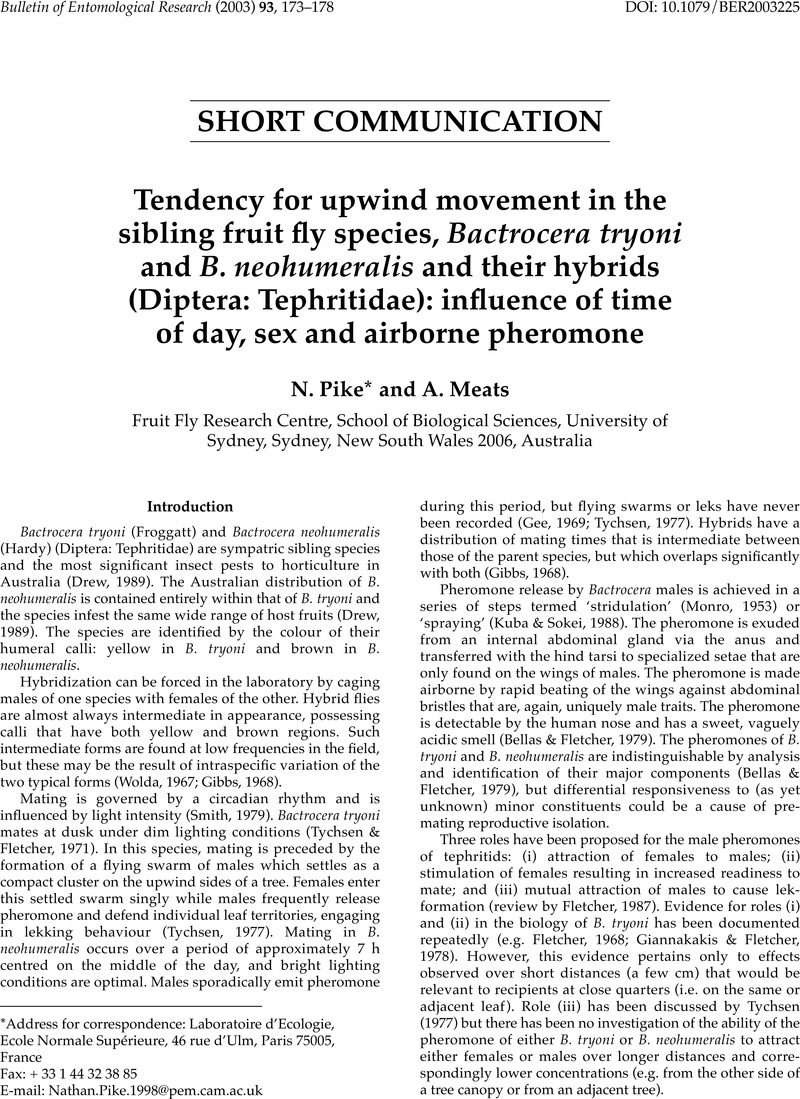Crossref Citations
This article has been cited by the following publications. This list is generated based on data provided by Crossref.
Thibout, E.
Arnault, I.
Auger, J.
Petersen, K. S.
and
Oliver, J. E.
2005.
Characterization of a Behaviorally Active, Gender-Specific Volatile Compound from the Male Asparagus Fly Plioreocepta poeciloptera.
Journal of Chemical Ecology,
Vol. 31,
Issue. 4,
p.
893.
Weldon, Christopher W
2007.
Influence of male aggregation size on female visitation in Bactrocera tryoni (Froggatt) (Diptera: Tephritidae).
Australian Journal of Entomology,
Vol. 46,
Issue. 1,
p.
29.
Clarke, A.R.
Powell, K.S.
Weldon, C.W.
and
Taylor, P.W.
2011.
The ecology of Bactrocera tryoni (Diptera: Tephritidae): what do we know to assist pest management?.
Annals of Applied Biology,
Vol. 158,
Issue. 1,
p.
26.
Dominiak, Bernard C
2012.
Review of Dispersal, Survival, and Establishment ofBactrocera tryoni(Diptera: Tephritidae) for Quarantine Purposes.
Annals of the Entomological Society of America,
Vol. 105,
Issue. 3,
p.
434.
Dominiak, Bernard C
Fanson, Benjamin G
Collins, Samuel R
and
Taylor, Phillip W
2014.
Automated locomotor activity monitoring as a quality control assay for mass-reared tephritid flies.
Pest Management Science,
Vol. 70,
Issue. 2,
p.
304.
Kovac, Damir
2015.
Reproductive Behavior and Basic Biology of the Oriental Bamboo-Inhabiting Anoplomus rufipes and a Comparison with Frugivorous Dacinae Fruit Flies.
Insects,
Vol. 6,
Issue. 4,
p.
869.
Ekanayake, EWMTD
Clarke, Anthony R
and
Schutze, Mark K
2017.
Effect of Body Size, Age, and Premating Experience on Male Mating Success in Bactrocera tryoni (Diptera: Tephritidae).
Journal of Economic Entomology,
Vol. 110,
Issue. 5,
p.
2278.
Shelly, Todd E
2018.
Sexual Selection on Leks: A Fruit Fly Primer.
Journal of Insect Science,
Vol. 18,
Issue. 3,
Pérez, Jeanneth
Park, Soo Jean
and
Taylor, Phillip W.
2018.
Domestication modifies the volatile emissions produced by male Queensland fruit flies during sexual advertisement.
Scientific Reports,
Vol. 8,
Issue. 1,
Noushini, Saeedeh
Park, Soo Jean
Jamie, Ian
Jamie, Joanne
and
Taylor, Phillip
2020.
Sampling technique biases in the analysis of fruit fly volatiles: a case study of Queensland fruit fly.
Scientific Reports,
Vol. 10,
Issue. 1,
Inskeep, Jess R
Taylor, Phillip W
Mainali, Bishwo
Rempoulakis, Polychronis
and
Weldon, Christopher W
2021.
Spatio‐temporal distribution of sexual calling behaviour in domesticated, sterile and wild Queensland fruit fly males under field cage conditions.
Pest Management Science,
Vol. 77,
Issue. 5,
p.
2522.
Akter, Humayra
Pérez, Jeanneth
and
Park, Soo Jean
2021.
Raspberry ketone supplements provided to immature male Queensland fruit fly, Bactrocera tryoni (Froggatt), increase the amount of volatiles in rectal glands.
Chemoecology,
Vol. 31,
Issue. 2,
p.
89.
Devescovi, Francisco
Hurtado, Juan
and
Taylor, Phillip W.
2021.
Mating-induced changes in responses of female Queensland fruit fly to male pheromones and fruit: A mechanism for mating-induced sexual inhibition.
Journal of Insect Physiology,
Vol. 129,
Issue. ,
p.
104195.



